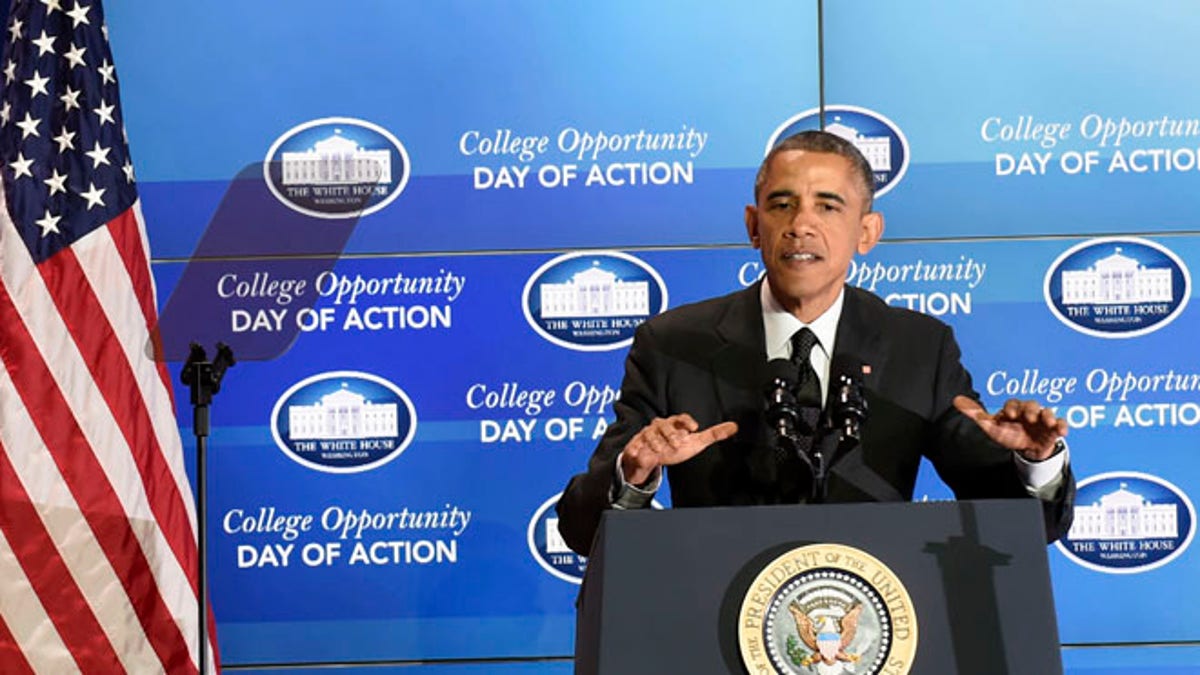
Dec. 4, 2014: President Obama speaks at the Summit on College Opportunity at the Ronald Reagan Building in Washington.
WASHINGTON – A controversial Obama administration rating system for colleges and universities already is being scrutinized ahead of its late-December rollout by educators who claim the government's goal of more transparency could come at the expense of schools that don't happen to fit the ivory tower model.
The federal government, with its long-awaited rating system, is trying to hold the country's 7,000 colleges and universities accountable not only to taxpayers, but also to prospective students trying to weigh the pros and cons of different institutions.
But it has many in the education community on edge. Several colleges and education associations have launched a preemptive PR strike against the plan, though the details haven't yet been released.
"I don't know how they can complain about something that isn't even out," a source at the Department of Education told FoxNews.com on condition of anonymity.
The ratings system, rumored to be released on Dec. 19, is likely to re-ignite the debate on the federal government's role in higher education. The Obama administration has had to balance its position as a cheerleader for innovation with its demands for colleges and universities to rein in tuition costs, while also pressing the institutions to produce more employable graduates.
The idea of a national rating system was pitched as a way to create more transparency in the government. Colleges and universities receive nearly $150 billion each year in federal loans and grants. Rating schools, the administration argues, is a way for American taxpayers to see whether the money is worth it.
But critics say the government should butt out and worry a broad system could lead to unintended consequences -- like creating perverse incentives for schools in pursuit of higher ratings. They worry it could hurt institutions that serve low-income and underprivileged students, as well as junior colleges and those that feature liberal arts programs.
"What we are opposed to is the federal government taking the factors IT thinks is important from a policy perspective and putting a federal letter grade INSTEAD of leaving that judgment up to students and families depending on their individual needs," Pete Boyle, vice president of public affairs for the National Association of Independent Colleges and Universities, told FoxNews.com in an email.
The Obama administration has pointed to spikes in tuition, dives in graduation rates and the growing weight of debts as driving factors for the national rating system.
But many in the higher education field say it shouldn't be up to the federal government to police colleges and universities.
"Most college and university presidents think the likelihood of producing a meaningful, useful and accurate rating system is very low but the risk for their institutions of being harmed by an inaccurate rating is pretty high," Terry W. Hartle, the American Council on Education's senior vice president for government and public affairs, recently told The Los Angeles Times.
Boyle said his group also is opposed "to a narrow metric or metrics that seek to grade an institution," echoing warnings from other higher education administration associations who believe the Department of Education needs to be mindful of making college more accessible for low-income, minority and at-risk students.
If the department fails, "there are likely to be unintended consequences on institutions with student bodies that consist of a majority of students that fit these profiles, receive Pell Grants, etc.," Boyle said.
Since the idea of a national rating system was first introduced in August 2013, several U.S. colleges and universities have expressed their concern. Some have dispatched lobbyists to Washington to persuade politicians to withhold funding -- arguing that a national rating system would lead to too much government intrusion and add another layer of unneeded bureaucracy.
Still, after 15 months of debates and discussion, many details of the new program remain a mystery. Federal officials have disclosed very little and say only a general conceptual framework of the system will be released the week before Christmas. The full plan is expected to be in place by next September.
"We invited not just speculation, but caused some anxiety [about the rating system]," Jamienne Studley, the DOE deputy undersecretary in charge of the plan, admitted during a speech to the American Association of Collegiate Registrars and Admissions Officers in California.
Unlike the Barron's, Princeton Review and U.S. News & World Report's annual "best" list -- which rank colleges -- the new system is expected to rate schools using tuition, financial aid, alumni earnings, debt and other graduation statistics.
Critics say the government's plan still misses the mark and fails to factor in other important data like graduation rates of transfer students. They worry the new system could also work against schools that serve large numbers of minorities as well as those that cater to professions like teaching and law enforcement versus schools that produce doctors and lawyers.
And while both the government and private educators have the same goal, Boyle believes the new rating system could result in a too-many-cooks-in-the-kitchen situation and pile on more problems for private and public colleges and universities.
The DOE is more optimistic and says the president's message of accountability not only to taxpayers but students has paid off.
"The president's call for a ratings system is already driving a necessary conversation about exactly the right kind of questions: What colleges are taking on the vitally important role of educating low-income students, and assuring that they graduate with good results? What educational practices might help schools lower the cost to students while improving or sustaining quality learning?" Studley wrote in a recent blog.




